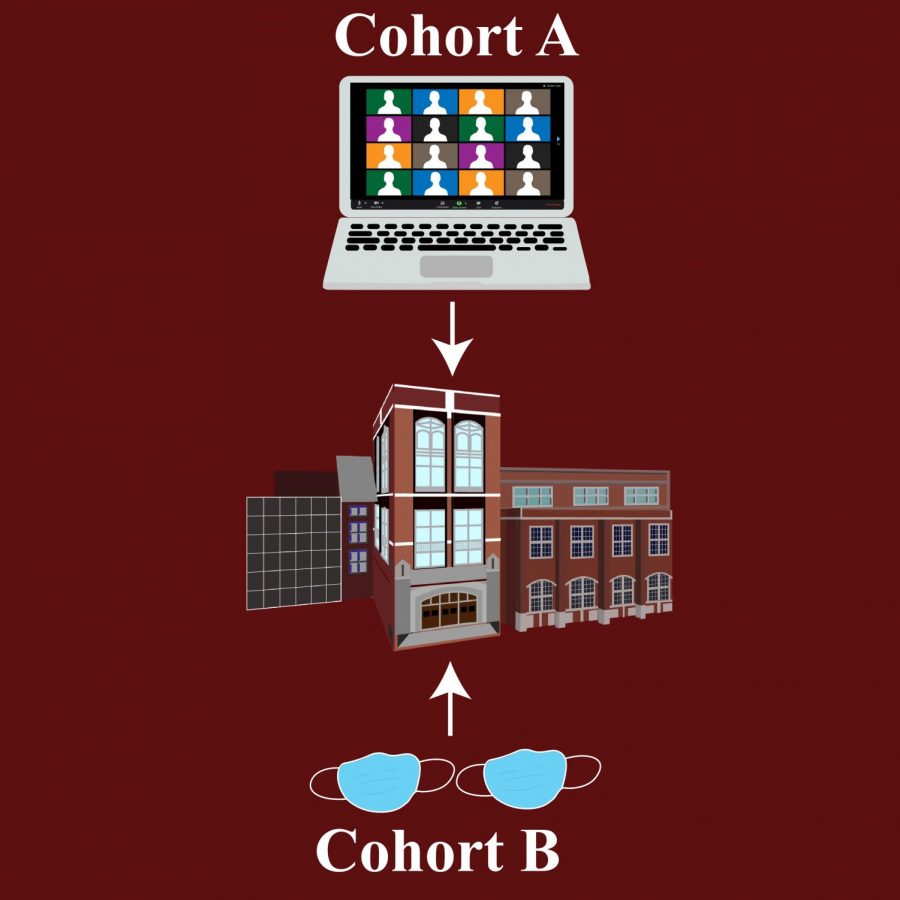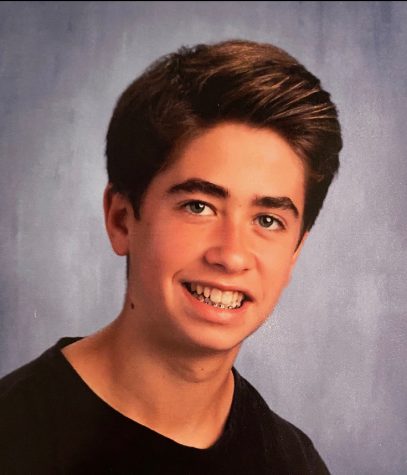Parents Express Disdain For Current Learning Model; Administration Plans For Cross Cohort Learning
October 15, 2020
Parents express disdain for current learning model: Administration plans for cross cohort learning
On Monday, October 5, Scarsdale’s Board of Education (BOE) convened to discuss whether hybrid learning is the correct approach to education. While the first segment of the meeting allowed the Scarsdale Teachers Association (STA) to voice their opinions, the second segment focused on gathering feedback from the community. A total of thirteen parents voiced their concerns for the current model, and many requested more synchronous and in-person learning. Since the restart committee spent the majority of the summer constructing the best possible schedule, many Scarsdale parents are infuriated with the limited in-person and synchronous instruction.
While nearby high schools such as Edgemont have half of their classes in-person, Scarsdale High School has minimal in-person hours, which many parents are concerned will be a disadvantage for their children. Specifically, SHS students are in school for two half-days during the week, and synchronous Zooms are held each afternoon except for Wednesdays, which are for asynchronous work and conferencing with teachers in open office hours.
The administration and teachers have already alluded that with the modified schedule and limited in-school time, it will be nearly impossible to know the extent to which the curriculum will be covered. Many classes have made the decision to omit up to two units of the curriculum, so that essential knowledge could be taught thoroughly. “There are plans to try to have optional or limited chances to Zoom in other cohort’s in-class time so that the teacher can complete the course of study needed,” said SHS Student Government Representative Patrick Kantor ’22.
While this potential schedule change would give teachers the opportunity to cover more of the curriculum, finding ways to teach both online and in-person at the same time could prove difficult and ineffective for teachers. “[Adjusting to distance learning] was a bit easier in the spring when it was all over zoom. Making adjustments was still a challenge and time-consuming, but I was adjusting to only one new format,” said Brittan Tramontana, a French teacher at SHS.
Parents also dislike the confusion surrounding the hybrid model, and many prefer synchronous hours in school over other options. “Honestly, I value in-person teaching the most. I have the highest regard for Scarsdale’s teachers and their talent, but the current model only allows for 20% of this experience,” explained Diane Gurden, a mother to two high school girls, who also attended the BOE meeting. “It would be great if we could increase [in-person hours] to the highest number possible, while still keeping everyone safe,” she added.
While asynchronous Zooms may be helpful, Gurden recognizes that students will need “to cap [their] screen time at a certain point.” Screen time is another significant factor that must be considered if cross-hybrid streaming becomes permanent. “One of the primary reasons why I elected to go in-person was because I wanted less screen time,” explained Joanna Wang ’21. Parents are worried that the new model will substantially increase screen time for students, which could further contribute to “zoom fatigue” and cause them to have difficulty concentrating. “I don’t think that cross hybrid streaming is a good idea because I feel like [it] reaches a point when you are just staring at your computer where it becomes counterproductive,” said Simone Glajchen ’21.
As a response to the BOE meeting, the administration and student government are experimenting with a cross-hybrid streaming schedule where students would watch a live stream of classes on the mornings of non-cohort days. “Since school started, there have been some teachers, parents, and students who have expressed interest in [cross-cohort streaming],” said Rishika Bansal ’22, the secretary for the school’s student government and a member of Scarsdale’s restart committee.
Teachers are not optimistic that they will be able to complete their curriculums given the current hybrid model. According to John Harrison, SHS social studies department chair, cross-hybrid streaming will be a useful tool to cover more American history. For other subjects, much is still uncertain. “It’s hard to say how much we’re going to be able to accomplish because we’re not quite sure how the rest of the year will unfold,” said Tramontana.
Given their burdensome workload, many students are unhappy with the newly proposed model. Because of the lack of in-person class, many teachers compensate and assign more classwork and homework. “When I’m at home during asynchronous time, I’m not just sitting around,” said Glajchen. “I’m always working and studying…whether it’s watching a video that my teacher told us to watch or studying for something in the future,” she added.
While parents are worried about the lack of in-person learning, most students feel that the current model is sufficient, and changes will only disrupt their learning. “I’m not worried about not learning enough because my teachers are really great and have worked hard to adjust the curriculum as they see fit,” explained Wang. Many students have admitted that screen time can not replace in-person learning. “If I’m taught the material in-person and someone else is taught the material virtually, it’s not fair because the person who learns it in person will have grasped it better. For cross streaming, people just won’t have the same understanding of the material,” said Crystal Feng ’22.
While many are content with the current hybrid model, due to the backlash from others, it is evident that cross-hybrid streaming, or some other alteration to the schedule, will become permanent in the next few weeks. “The school is always looking for new [ways] to make our experiences better. Some teachers will begin experimenting with cross-cohort streaming, and we will be continuing our discussion about whether it’s the best way to move forward,” concluded Bansal.
The Case for Cross-Cohort Streaming
While cross-cohort streaming can prove effective in some cases, mandating its implementation will cause more harm than good.
This article features the thoughts, opinions, and reflections of two SHS students: Michael Waxman ’21, SHS Student Body President, and Simran Ruta ’21, SHS Student Body Vice President.While neither are Maroon staff members, both participate in cross-cohort streaming as a part of their senior A.T. U.S. Government and Economics class.
As students—one hybrid and one virtual— in one of two classes in the school that have implemented cross-cohort streaming, we have a unique perspective on the experience. As long as cross-cohort streaming is used to push curriculum forward and replaces asynchronous work proportionally, we believe it has the potential to improve the learning experiences of both hybrid and virtual students.
As a member of the hybrid community, I, Michael, believe cross-cohort streaming can become a valuable asset for learning this year. I have had the opportunity to participate in cross cohort-streaming on both ends—Zooming in and attending in-person—and experienced both positively. I feel that the success of cross-cohort streaming has a lot to do with the teacher. When Zooming in, my teacher made a point to make me, and the rest of Cohort B, feel included in the discussion. He constantly called on the virtual students and made sure that we were engaged. By using cross-cohort streaming, we were able to extend class discussions and ask more questions. With this added class time, there is less of a sense of rush in terms of the curriculum being covered, and thus more time for in-depth learning. As long as cross-cohort streaming replaces the proportional amount of asynchronous work, I think it is the superior learning tool. My best learning occurs when I have the opportunity to engage in class discussions, which is a key component of cross-cohort streaming. As much as I think cross-cohort streaming has potential, it must be used correctly to be effective. The teacher must use the tool to advance curriculum—not repeat the same material—and must regard the in-person students in the same manner as those online. If these criteria can be met, I believe more teachers should use cross-cohort streaming going forward.
As an all virtual student, I, Simran, initially thought that cross-cohort streaming was going to be a negative experience. On days where my cohort goes into school, I have to be on the computer from 8-3, most of the time zooming into classes alone. Sometimes teachers will put me on the smartboard, which is not ideal and isolates me further. These seven hours on Zoom are matched with several more hours of asynchronous work. However, I have found attending morning classes through Zooms with the presence of other members of the opposite cohort to be quite pleasant. Although I still do not feel completely connected to the class, the other students Zooming in alongside me can relate and therefore it feels a lot more comfortable. However, this is also dependent on the teacher. My experience with cross-cohort streaming has been positive as a result of the teacher’s efforts to engage with the online students and his commitment to assigning less asynchronous work. If Scarsdale were to adopt a cross-cohort streaming policy, it would be necessary to have stricter guidelines on the amount of asynchronous work (which is really just code for more homework) teachers can assign.
2020 is going to be a year of trial and error. There is no adequate replacement to a fully in-person Scarsdale High School education, but, with open minds, we can create an experience that comes close. Cross-cohort streaming is an effective tool that, when used correctly, can enhance the learning of all students and create a more connected and engaging learning environment.
The Case Against Cross-Cohort Streaming
While cross-cohort streaming can prove effective in some cases, mandating its implementation will cause more harm than good.
This article features the thoughts, opinions, and reflections of Robert Fogel ’21. While Fogel is not a Maroon staff member, he has participated in cross-cohort streaming as a part of his senior A.T. U.S. Government and Economics class.
Scarsdale High School’s recent announcement that students will soon start cross-cohort streaming has led to yet another controversy in the school community. The purpose of the new plan is to increase synchronous learning time to allow students to learn more material. A significant percentage of students, the group most impacted by the decision, disagree with the administration’s outlook and are against such measures, and not because we want less school. Although this method of learning is effective when used sparingly, requiring teachers to regularly integrate this practice will have the converse effect of its intention, leading to ineffective learning and damaging students’ mental and physical health.
There are benefits to cross-cohort streaming. I have had a great experience thus far in my one class that has already begun to cross-stream—Mr. Harrison’s twelfth-grade government class. On the Zoom, I feel fully engaged. Students are able to give presentations and ask questions over Zoom, and the two cohorts are integrated. All teachers could benefit from implementing a degree of cross-cohort streaming when needed; the issue presents itself when all teachers do it. If all teachers engage in cross-cohort streaming, the learning experience of students will decline in quality. Students will potentially have up to 6 hours straight on Zoom classes, with only a 45-minute break for lunch and 5-minute increments between classes. By the end of the hybrid school-day, it becomes difficult to pay attention, listen, and learn over Zoom. The hours on the screen can make lessons and learning go in one ear and out the other. This has nothing to do with the teachers; staring at a screen is, by nature, unengaging and tiring. Students’ ability to concentrate will be spent halfway through the day, and the afternoon classes will become ineffective. There has also been little to no guidance on how virtual-only classes will function in this new model, as students will be required to Zoom into these classes from the halls of school, placing them in a distracting environment not suitable for learning. The purpose of these added streaming hours is to increase the material learned, yet the analysis of the plan strongly suggests a diminished ability for students to learn effectively.
In addition to actually reducing the quality of students’ engagement and learning, the new plan will impact many students’ mental and physical health. Students in Scarsdale already demonstrate high levels of anxiety and depression. On top of the other pressures of learning in a new environment in the midst of a deadly pandemic, the screen time of cross-cohort streaming will harm students’ mental health. Many argue that cross-cohort streaming gives students the same number of school hours that they used to have. The key difference, however, is that the new school day is entirely viewed on a screen. The blue light emitted from screens not only causes headaches and eye-strain but can lead to potential long-term retina damage.
I understand that the school administration is attempting to do its best in these difficult and unprecedented times. As a student, however, what frustrates me most is that students’ opinions were not taken into account. The administration only created a survey after the plan was announced to respond to the growing frustrations of what seems to be a minority in the community. Protecting students’ health and maximizing learning are the school’s top priorities, and while the school is doing a great job at reducing the spread of COVID-19, cross-cohort streaming will fail to maximize learning while damaging the physical and emotional health of the students. A potential new plan could allow teachers to engage in cross-cohort streaming when needed but not require the teachers to do so regularly. Teachers have clearly worked hard to ensure that asynchronous learning is both engaging and productive. Eliminating this for long screen-based hours will only dilute our learning and harm our health. I urge the administration to revise its plan.




